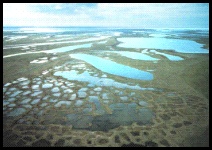
 Arctic Wetland There are five basic types of Arctic wetland - bogs (lowland polygon bogs, peat mound bogs), fens, swamps, marshes, and shallow open water. Bogs and fens are the most common. Bogs usually have a surface carpet of mosses. You may wonder how one can talk of abundant wetland when the Arctic is, in fact, a desert. Aren't deserts dry places? No. A desert is defined by the amount of precipitation (rainfall or snowfall), and the Arctic gets very little of that. The water in the wetlands comes from melting ice and snow. Permafrost plays an important part in the formation of almost all Arctic wetlands and lakes. It remains under the wetlands at shallow depths and creates a barrier of frozen earth that prevents the water from draining away. The other main factors are very low precipitation and cold temperatures. This restricts wetlands to poorly drained depressions or to areas where additional water is available.
Click pictures for more information and credits. Library: Arctic, Land Environment/Atmosphere, Ice, Snow Links: Arctic Arctic Maps & Weather Reports |

|
DICTIONARY: Just "double-click" any unlinked word on this page for the definition from Merriam-Webster's Student Electronic Dictionary at Word Central. |

|
ARCTIC LIBRARY & GLOSSARY: Check this section for an index of the rest of the things you really need to know about the Arctic. |

|
ARCTIC MAPS & WEATHER REPORTS: Maps of the Northwest Passage, explorers' routes, iceberg sources, Nunavut, the Arctic by treeline, temperature... |

|
ARCTIC LINKS: Even more information! Links to sites related to the Arctic and "Iceberg: the Story of the Throps and the Squallhoots". |

|
GUIDE TO ARCTIC SUNRISE & SUNSET: How much sunlight or darkness is there in the Arctic on each day of the year? |
to is the property of their respective owners, and Athropolis is not responsible for their content.